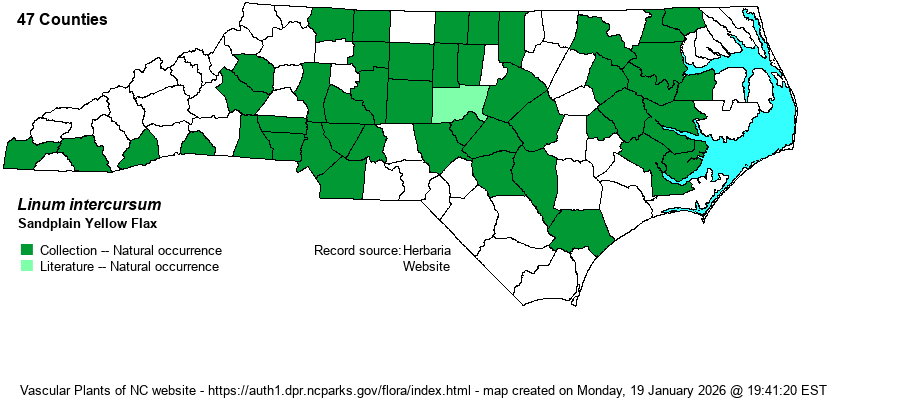| Author | Bicknell | |
| Distribution | This species was included within L. virginianum var. floridanum in RAB (1968), and nearly all of the county records in that references from the northern Coastal Plain, Piedmont, and Mountains now belong to L. intercursum, as opposed to the now split out L. floridanum. L. intercursum occurs nearly statewide, seemingly absent from nearly all of the Mountains, and likely parts of the extreme southern Coastal Plain.
This species has an Eastern range, from MA south to southern FL and west to LA. | |
| Abundance | Fairly common to frequent in the Coastal Plain and Piedmont, but uncommon in the southern Mountains. Apparently absent in most of the Mountains. The distribution of specimens essentially across all of the Piedmont and Coastal Plain, and given its likelihood of being overlooked by collectors, it likely should be an S5 species in NC. The website editors recommend S5?, which means a recommended Global Rank of G5? as well. | |
| Habitat | In VA, the habitats are listed as "Dry, clay or sandy soil in clearings, open forests, woodlands, and roadsides; sometimes in alternately wet and dry, hardpan soils" (Digital Atlas of the Virginia Flora website). Habitats listed on several herbaria collections span the range from savannas to upland oak-hickory forests! | |
| Phenology | Blooms and fruits from June to October. | |
| Identification | The Linum species are quite difficult to identify, especially as many of the former varieties and subspecies have now been elevated to full species. All are erect herbs to 1-2 feet tall, with slender branches that are usually ascending, small and narrow leaves, and numerous scattered small yellow flowers (with 5 petals) along the upper portions of the branches. This species is separated from some species by "Fruit as long as broad or longer, its apex acute, apiculate, or obtuse" and opposed to "Fruit broader than long, its apex depressed, flattened, or broadly rounded" (Weakley 2018) in some others. Among the first group, it is separated from L. floridanum by broader leaves and fewer leaves below the inflorescence; in L. intercursum the leaves are 2.3-4.3 mm wide, and mostly 25-50 leaves below the inflorescence; as opposed to leaves mostly just 1.3-2.0 mm wide and 50-165 leaves below the inflorescence in L. floridanum (from Weakley 2018). | |
| Taxonomic Comments | As mentioned above, some references include this species within L. floridanum, and others within L. virginianum var. floridanum.
Website editors have received much help in species boundaries and in identification from Rogers (1963, 1984). | |
| Other Common Name(s) | Bicknell's Yellow Flax, Sandplain Flax | |
| State Rank | S2? [S5?] | |
| Global Rank | G4 [G5?] | |
| State Status | | |
| US Status | | |
| USACE-agcp | FACU link |
| USACE-emp | FACU link |

